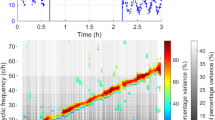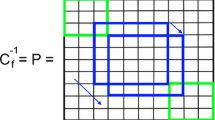Abstract
We describe and illustrate methods for obtaining a parsimonious sinusoidal series representation or model of biological time-series data. The methods are also used to identify nonlinear systems with unknown structure. A key aspect is a rapid search for significant terms to include in the model for the system or the time-series. For example, the methods use fast and robust orthogonal searches for significant frequencies in the time-series, and differ from conventional Fourier series analysis in several important respects. In particular, the frequencies in our resulting sinusoidal series need not be commensurate, nor integral multiples of the fundamental frequency corresponding to the record length. Freed of these restrictions, the methods produce a more economical sinusoidal series representation (than a Fourier series), finding the most significant frequencies first, and automatically determine model order. The methods are also capable of higher resolution than a conventional Fourier series analysis. In addition, the methods can cope with unequally-spaced or missing data, and are applicable to time-series corrupted by noise. Fially, we compare one of our methods with a wellknown technique for resolving sinusoidal signals in noise using published data for the test time-series.
Similar content being viewed by others
References
Billings, SA, Leontaritis IJ (1982) Parameter estimation techniques for nonlinear systems. IFAC Symp Ident Sys Param Est 1:427–432
Box GEP, Jenkins GM (1976) Time series analysis: forecasting and control. Holden-Day, San Francisco
Cooley JW, Tukey JW (1965) An algorithm for machine calculation of complex Fourier series. Math Comput 19:297–301
Dwight HB (1960) Tables of integrals and other mathematical data. Macmillan, New York
French AS, Butz EG (1973) Measuring the Wiener kernels of a nonlinear system using the fast Fourier transform algorithm. Int J Control 17:529–539
Haber R, Keviczky L (1976) Identification of nonlinear dynamic systems. IFAC Symp Ident Sys Param Est 1:79–126
Ho T, Kwok J, Law J, Leung L (1987) Nonlinear system identification. Project Rept ELEC-490, Department of Electrical Engineering, Queen's University, Kingston, Ontario, Canada
Kay SM, Marple SL (1981) Spectrum analysis a modern perspective. Proc. IEEE 69:1380–1419
Korenberg MJ (1973) Identification of biological cascades of linear and static nonlinear systems. Proc Midwest Symp Circuit Theory 18.2:1–9
Korenberg MJ (1985) Orthogonal identification of nonlinear difference equation models. Proc Midwest Symp Circuit Sys 1:90–95
Korenberg MJ (1987) Fast orthogonal identification of nonlinear difference equation and functional expansion models. Proc Midwest Symp Circuit Sys 1:270–276
Korenberg MJ (1988) Identifying nonlinear difference equation and functional expansion representations: the fast orthogonal algorithm. Ann Biomed Eng 16:123–142
Korenberg MJ, Bruder SB, McIlroy PJ (1988a) Exact orthogonal kernel estimation from finite data records: extending Wiener's identification of nonlinear systems. Ann Biomed Eng 16:201–214
Korenberg MJ, French AS, Voo SKL (1988b) White-noise analysis of nonlinear behavior in an insect sensory neuron: kernel and cascade approaches. Biol Cybern 58:313–320
Lee YW, Schetzen M (1965) Measurement of the Wiener kernels of a nonlinear system by cross-correlation. Int J Control 2:237–254
Marmarelis PZ, Marmarelis VZ (1978) Analysis of physiological systems. The white noise approach. Plenum Press, New York
Marmarelis PZ, Naka K-I (1972) White noise analysis of a neuron chain: an application of the Wiener theory. Science 175:1276–1278
McIlroy PJH (1986) Applications of nonlinear systems identification. MSc Thesis, Queen's University, Kingston, Ontario, Canada
Mohanty NC (1986) Random signals estimation and identification. Analysis and applications. Van Nostrand, New York
Nugent ST, Finley JP (1983) Spectral analysis of periodic and normal breathing in infants. IEEE Trans Biomed Eng 30:672–675
Palm G, Poggio T (1978) Stochastic identification methods for nonlinear systems: an extension of the Wiener theory. SIAM J Appl Math 34:524–534
Rice JR (1966) A theory of condition. SIAM J Numer Anal 3:287–310
Sterman MB (1981) Power spectral analysis of EEG characteristics during sleep in epileptics. Epilepsia 22:95–106
Wiener N (1958) Nonlinear problems in random theory. Wiley, New York
Author information
Authors and Affiliations
Rights and permissions
About this article
Cite this article
Korenberg, M.J. A robust orthogonal algorithm for system identification and time-series analysis. Biol. Cybern. 60, 267–276 (1989). https://doi.org/10.1007/BF00204124
Received:
Issue Date:
DOI: https://doi.org/10.1007/BF00204124




